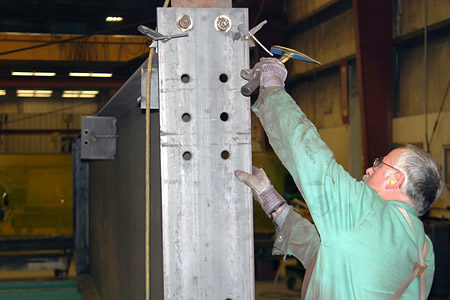
Home » West Plains fabricator adds capacity
West Plains fabricator adds capacity
Plant upgrades to enable Garco Building Systems to serve sister companies

July 14, 2011
Garco Building Systems Inc., the Airway Heights pre-engineered building maker, is increasing its production capacity with new equipment that enables it to fabricate structural components and steel panels for several sister companies.
Garco, which Houston-based NCI Building Systems Inc. bought in 2007, is integrating shared systems that can fabricate products that can be used throughout NCI's subsidiaries, says Garco plant manager Joe Hanson.
"We're changing from a proprietary Garco plant to a hub plant," Hanson says. "We'll be doing up to five brand names out of here."
The company designs structures—mostly industrial and commercial buildings—to custom architectural specifications. The components are fabricated at the plant and shipped to a construction site to be assembled by a project owner's contractor.
The manufacturing-hub concept has been in the works since shortly after NCI bought Garco, says Mark Radmaker, Garco's engineering manager.
"We recently made significant progress," Radmaker says.
NCI has spent several million dollars on new and upgraded equipment at the 140,000-square-foot plant at 2714 S. Garfield Road, says Dan Rauscher, an operations executive at Garco.
The company updated its steel-panel manufacturing line in June, Hanson says. Other improvements under way include installing an automated plasma cutter in the plant's burn center, which will enable Garco to process more than 200 tons of steel components a week—more than double the plant's current capacity of 80 tons per week, he says.
In addition to the new equipment, the hub concept required training employees on new computer software and design programs.
NCI operates 12 pre-engineered building system subsidiaries under their original names to maintain regional brand recognition, Hanson says. Garco, for example, is well known in the Pacific Northwest, Alaska, and western Canada for its heavy pre-engineered buildings, he says.
"Garco is an important regional base," Hanson says.
The company says it had 108 employees as of July 1, down from 113 employees a year earlier.
Roughly half of the employees work in the front office, which handles engineering, design, and sales. Most of the rest work in the plant, where employee numbers fluctuate depending on sales orders.
"The good news is that our people in the plant can look forward to more steady work," Hanson says.
While ramping up to be able to make products for sister companies, Garco also is hoping to increase its own sales in the Northwest.
"We'realways going to be Garco Building Systems," Hanson says.
Garco's annual revenues peaked at about $40 million in 2006 and then fell sharply during the recession, and two years ago, Garco laid off about 40 percent of its work force, Rauscher says. "We haven't recovered from that," he says.
Garco says its sales totaled $24.4 million in its 2010 fiscal year, down from $25.6 million the year earlier.
"We're trying to get back up to $30 million, but we had a slow start this spring," Radmaker says.
Even though sales are well below historic highs, Garco has seen positive signs that sales might be improving, Radmaker says. In recent weeks, he says, "we've sold more than in the first five months of the year."
NCI also has gone to a common engineering and design platform, meaning Garco is able to take on engineering and design tasks for other NCI subsidiaries, Radmaker says.
"We'll be able to work on designs for a building to go in Washington state in the morning, and one for a customer in New York in the afternoon," he says.
In one of its larger current jobs, Garco Building Systems recently landed a $2.5 million contract to supply building systems for the Gibraltar copper and molybdenum mine in central British Columbia, Canada, Rauscher says.
Latest News
Related Articles


![Brad head shot[1] web](https://www.spokanejournal.com/ext/resources/2025/03/10/thumb/Brad-Head-Shot[1]_web.jpg?1741642753)

